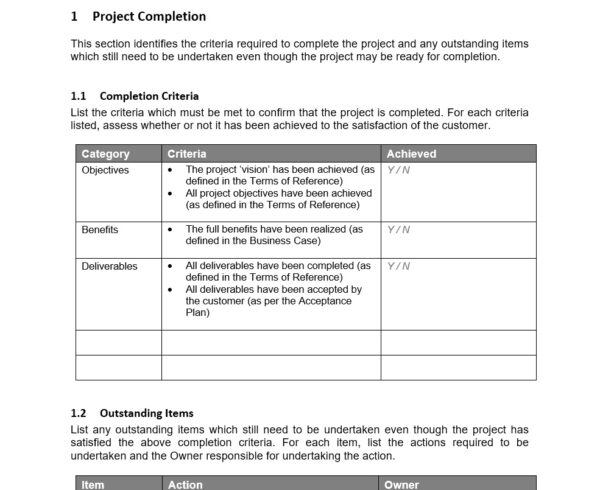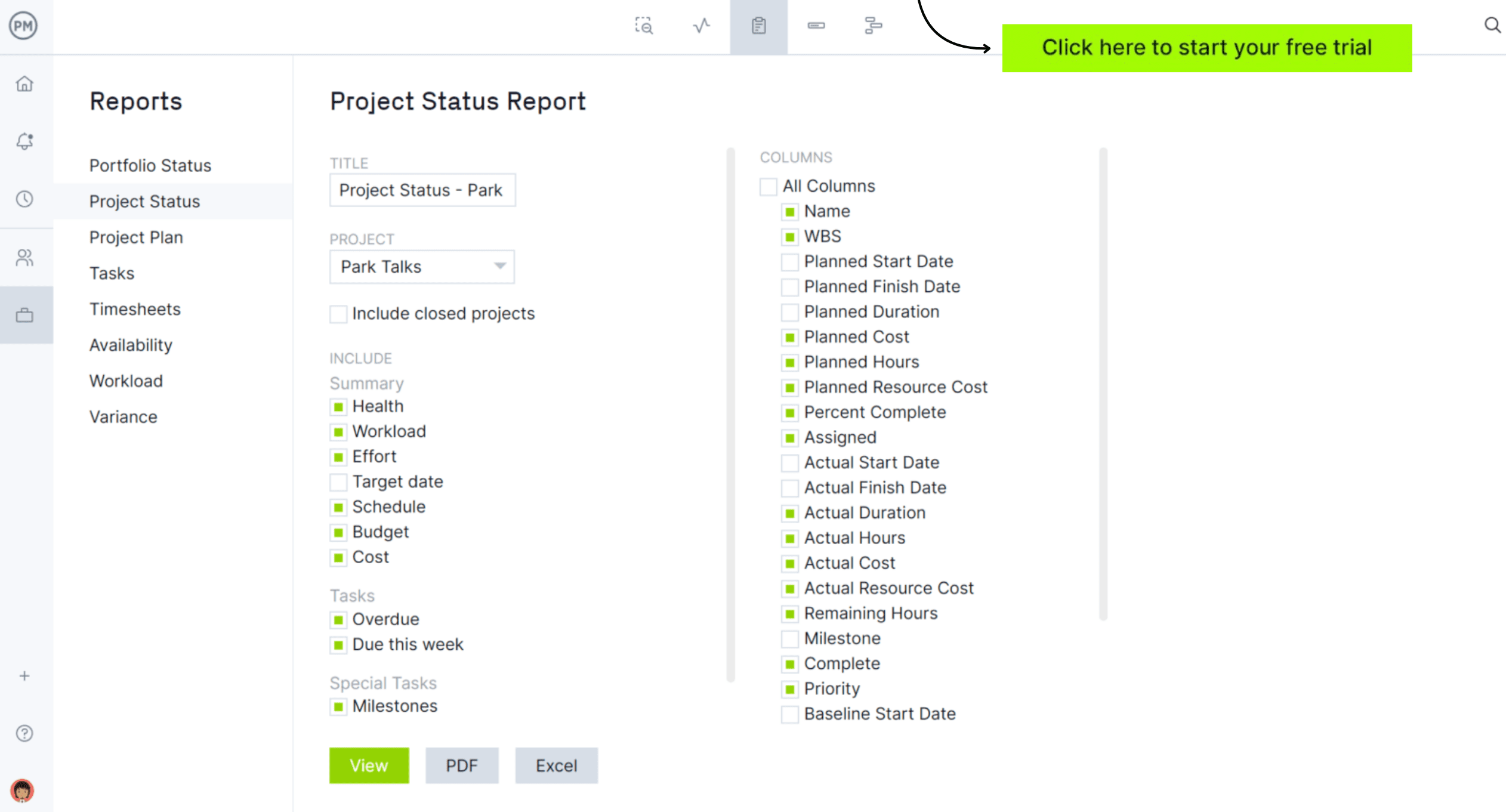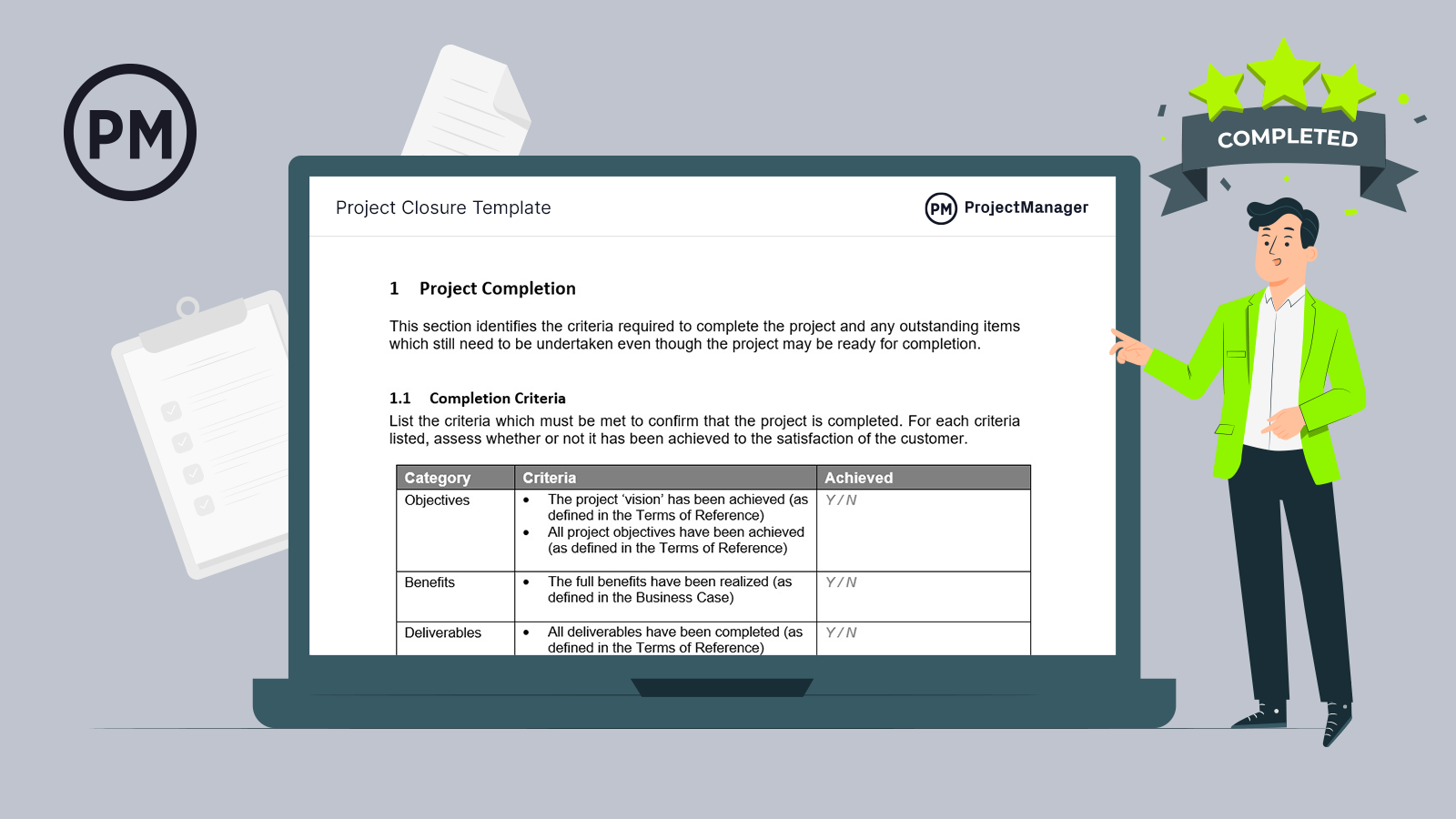All good things come to an end. Projects are no exception. It’s necessary to define completion criteria so that when your project ends, you can close and transfer the right documentation to the right people. The end of a project is but one of your project’s phases.
Why You Need a Project Closure Template
Project managers work hard to plan and execute their projects, but it’s important to not neglect the end. It’s as critical as every other part of the project and needs the same amount of attention. Project closure, being the final phase of the project, is when all the documents have to be signed and finalized, all the reports delivered. Therefore, our project closure template is crucial if your aim is to keep thorough documentation on your project.
Ideally, you should follow a procedural checklist to close your project before you move on to the next assignment. That includes reviewing the lessons you’ve learned during the course of the project. What things would you do differently? What methods proved successful?
By collecting this information, you can both avoid making the same mistakes twice—and double down on the techniques that are shown (through experience) to work.

Then, there are the approvals. You’ll need to get them for your stakeholders. They will need to literally sign off on a project, so get those signatures! There are also the contracts you’ve made with team members, contractors and vendors. You’ll need to make sure they’ve been properly fulfilled, and then close them out. You can’t move on from one project to another without having these items taken care of.
Money is an important facet of the final stage of your project. You’ll need to make a list of the complete and final costs for the project to ensure that you met your budget. This is also when you’ll be making payments to team members, contractors and vendors—not to mention any services you used during the completion of the project. Make sure everyone is paid!
Ending one project usually dovetails into the start of another, so one more responsibility to close the finished project is to get transition support to help facilitate the changeover. Then you can release resources, archive documentation and, last but not least, celebrate the success of the project. This final point is not to be taken lightly. The team worked hard, by rewarding them you build loyalty and help retain the best workers for future projects.
Does this sound like a to-do list? It is, and project management software can help you better manage all the items on your to-do list to make sure nothing is neglected. Using ProjectManager’s list view gives you greater control and connectivity to streamline the process. Because our tool is cloud-based, stakeholders, teams and vendors have access anywhere and at any time to sign off on work. Plus, you can use our in-depth reports to get all the project data you need for use on future projects before you close out. You can even make custom templates from existing projects, so you don’t have to start from scratch for new endeavors. Get started for free.

How to Use a Project Closure Template
You’ve downloaded our free template, but if it just sits on your hard drive, then it’s no good for anything or anyone. You have to take this document and use it as a tool in the final stage of your project. It’s a great receptacle to collect all the information needed to properly put a project to rest. This is how to get started.
1. Document Information
This field is where you can begin to organize the documents that have been flying around your project since day one. Get the document ID down, the owner of the document and when that document was first issued. From there you need to note the last time the document was saved, which will ensure you’ve got the most up-to-date data possible. Then, finally, write down the document name. All this information is critical to getting on the road to closing these documents for good.
2. Document History
Here is where you want to collect the history of each of your documents as they changed throughout the lifecycle of the project. One column is where you note the version of the document. Then in the next column, write down the date the document was issued. The last column is where you can explain what the changes were in the document. This all helps to keep a paper trail that explains the various twists and turns that occur in any project.
3. Document Approval
Here’s where you get your sign-offs. Every person of responsibility is listed in the first column under their role, from the project sponsor and project review group to the project manager and any other applicable positions. They each need to approve of the documents you’ve collected for the project closure by printing and signing their names and dating the act. Only after that can you consider the document complete.
Project Closure Template Tips
Closing a project is more than getting the final deliverable to your stakeholder on time and within budget. Project closure is the final stage of project management for a reason. It ties up the loose ends of a project and makes sure that it’s done properly. The last thing you want to do is have to deal with signoffs and open contracts long after you’ve moved on to another project.
Therefore, like any other stage of your project, there are best practices when closing a project. Here are a few to help you end your project correctly.
Have a Plan
Don’t wait until the last minute to figure out how to close your project. Just as you plan for executing the project, you need to have a process in place for when the project comes to an end. Therefore, define the procedure in the project charter at the beginning of the project and make sure your stakeholders sign off on it.
Get Signoffs
Having stakeholders sign off on final deliverables seems like an obvious step when closing a project, but even something this important can be forgotten in the rush that follows the completion of the project. Have a document ready that reviews the steps leading to the final deliverable, including reviewing the goals and objectives, the deliverable, success criteria, maintenance after the deliverable goes live and finally a signoff that it’s acceptable.
Lessons Learned
Sometimes called a post-mortem, it’s a period of reflection with your team when you go over the project that has just been completed and to discuss what did and did not work. Talk about leadership, successes, challenges and how to save time, money and improve the quality of the project. Document this process because it should be filed away and used as historical data when figuring out the feasibility of new, similar projects.
Archive Project
The lessons learned stage above requires documentation that can then be accessed in the future to guide similar projects. It can act almost like a summary. But you want to archive every piece of documentation from the project once it’s been completed. This will help in planning new projects, but also for any audit purposes. Be sure to keep all the documents filed together, so it’s easy to find them when you need them.
How to Use a Project Closure Template in ProjectManager
You’ve got this template to get all your project documents in one place and track them, which is great. It’s helpful. But imagine this document wasn’t a standalone and static one, but something that lived in your project management software. Well, you don’t have to imagine anymore. With ProjectManager you can take what is essentially a project checklist and turn it into so much more.
Much of the work of closing a project can be accomplished automatically. Set up notifications and share documents through ProjectManager[’s cloud-based platform. This ensures that everyone is given the opportunity to finish their paperwork on their time and within their own schedule. That beats having to get busy people all in the same room. Or having a loose document floating around from person to person where it could get lost in the process.
Better still, ProjectManager integrates with many other helpful applications to further ease the process of closing a project. For example, in order to keep track of all the accounts that have invoiced over the lifecycle of the project, including any commissions, fees and bonuses, you can integrate an online invoicing tool. This helps not only pay your resources but vendors and helps build strong and long relationships. That makes for an even better foundation for your next project.
Other Templates to Complement Your Project Closure Template
Project closure is one of the five stages of a project, and like the other four, it’s not simply locking the doors and turning off the lights. It takes a great deal of work to shut down any project, and to help with that process, we have these additional free project management templates to help you manage it all.
Lessons Learned Template
We talked about the importance of spending time to document issues that arose during the project in addition to the things that went right. Our free lessons learned template was created to help you capture all this important data in a worksheet. The template has two categories, one for success and another for the problem. There’s also space to fill in the date, project, manager, notes as well as any ideas that come up in the discussion.
Change Log Template
Chances are, as you close a project and go through the lessons learned, there will be some (if not many) changes. In order to ensure that these changes are not filed away and forgotten, use our free change log template. In it, you’ll find a place to capture all the relevant data, such as project name and manager. It allows you to number each change so it’s easy to track. You can also identify the type of change request, describe it, note the status, priority and when it should be resolved, including who is tasked with doing so.
Budget Template
During the final review of your project, you’ll want to double-check your budget and expenses to make sure you spent what you thought you spent. Our free budget template can help you in this process by allowing you to input your budget and expenses and see if the calculations match up. Here, you’ll be able to collect labor and material costs, and other line items, then compare your planned versus actual budget.
Related Content
Closing a project can be a complicated endeavor. There are many strands of the project that have to be collected and tied up in a neat knot before you can say the work is finally done. The free project closure template is a great start to managing that process, but you probably are going to want and educate yourself on the end phase of a project.
That’s where ProjectManager has your back. We’re not only an award-winning project management software product, but publish a regular blog on our site, with informative articles and videos geared for both the “accidental project manager” and the experienced professional. We’ve gathered three relevant posts for you to link to, but feel free to look around the site where you can find more articles, videos and guidebooks.
Try ProjectManager Free for 30 Days
The right way to close a project is but one of the many phases of planning, tracking and reporting on a project. All of those phases and more are addressed in the many tools and features in the award-winning ProjectManager.
With ProjectManager you get a cloud-based program to take your project management online and make it more collaborative with team members and stakeholders alike. Our software repeatedly is ranked #1 for project management applications by Gartner’s GetApp.
See for yourself why everyone who is leading a project, whether big or small, is saying that ProjectManager is making their job easier and helping them be more productive and efficient when leading a project. Visit ProjectManager to try out the software free with a 30-day trial, and let us know what you think!
